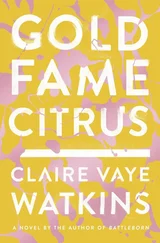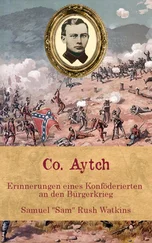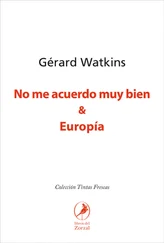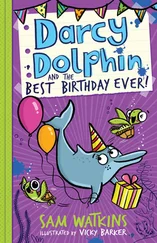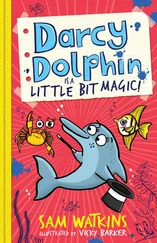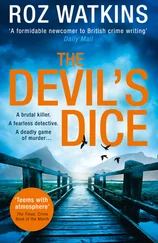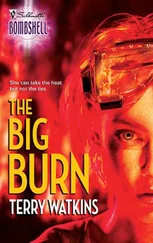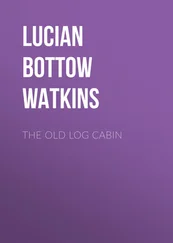At eight o’clock Lena changes out of her uniform and wets her hair and underarms at the bathroom sink and then the two walk out into the parking lot with their soiled uniforms balled under their arms, their apron strings trailing along the asphalt, as though they don’t have to be back for tomorrow’s dinner rush, as though they don’t have to be back ever again.
On the road, all there is is desert and night and the taillights of the cars ahead of them. The radio comes in and out. Once, without taking her eyes off the road, Lena says, I should have done it with him. I don’t know why I didn’t. Our girl says nothing, only nods. When Lena swings the Neon around the final curve of the mountain range separating their town from Las Vegas, they see light sweeping across the valley floor like a blanket made of lights, like light is a liquid and the city is a great glistening lake.
Lena sucks a little saliva from her over-large teeth and asks is it okay if they turn the radio off. She has never driven in the city. Our girl says, That’s cool, because the radio is suddenly nothing compared to the billboards and limos and rented convertibles and speakers embedded in the sidewalks emitting their own music into the air, and because she’ll say anything to soothe Lena, to keep her driving.
Our girl directs Lena to park on the top floor of the parking garage at the New York New York. It is June 2001. This is the Las Vegas that has recently given up on becoming what they were calling a family-friendly vacation destination. The waterslides and roller coasters and ice-skating rinks that were once part of the megaresorts have been torn down to make room for additional hotel towers, floor space, and parking garages like this one. Lena pulls hard on the parking brake, the way her mother taught her. She moved from Minnesota her freshman year, when her mom was offered a job as the Nye County health nurse. Her parents have been divorced since before she can remember. She sees her father, an accountant, on Christmas and Easter, and lives with him in St. Paul for five weeks during the summer. Lena doesn’t know anything about what was once Wet ’n’ Wild or MGM Grand Adventures. Our girl spent her birthdays and end-of-year field trips in such places and could be saddened by their vanishing, could consider it the demolition of her childhood. But thoughts like these will not come to her for years.
Lena has a tube of waterproof mascara and a peacock blue eyeliner pencil in her purse. Our girl has vanilla-bean body spray and kiwi-strawberry lip gloss and gum in three different incarnations of mint. All these they trade in the front seat of the Neon until both are eyelined and fragrant and fresh-mouthed. From the parking structure they walk through the New York New York. The shops in the casino are façaded with half-scale fire escapes and newsstands and mailboxes with graffiti replicated on the side. They sell Nathan’s Famous hot dogs or tiny Statue of Liberty erasers and key-chain taxicabs and all varieties of shot glasses.
Our girl leads the way. The floor is busy carpet or plastic cobble. Tacky, her mother would call it, dully. The ceiling is lit to suggest stars glittering at twilight, as is popular along the Strip at this time. A bulbous red glittered apple rotates above a stand of slots. Our girl ignores the directional signs, which point down circuitous routes pitted with pocket bars and sports books. Once, Lena touches her lightly, thinking they’ve lost their way. Our girl says, Trust me, and Lena does.
Outside there is a breeze threading through the warm night and a jubilant honking of cars and all those billions of bulbs flashing in time, signaling to the girls that they are, at long last, alive. Across Las Vegas Boulevard is an enormous gold lion posing regally in the mist of a fountain. The lion is the property’s second; the original—a formidable openmouthed beast forged in midroar—was replaced because it frightened some Chinese tourists and was considered bad luck by others. Down the expansive block is an unimpressive aging Camelot, and beyond that a black glass pyramid, the apex of which emits a thick rope of light supposedly visible from space. The girls set off in the opposite direction, toward an ever-expanding ancient Rome and, across the palm-lined, traffic-clogged boulevard, the Eiffel Tower, where our girl’s stepfather poured concrete during phase two. They cross a Brooklyn Bridge, its waters strewn with coins, and pass before the wood-toothed mouth of a grinning Coney clown that will be demolished long before either girl reveals the happenings of this night to anyone.
The weekend crowds are dense on the sidewalks and mostly foreign or Midwestern. This allows the girls to amuse themselves at intersections by grasping hands, stepping off the curb against a red light, and glancing backward to see the crowd follow in their wake, taxicabs honking wildly. They have a teenage sense of their surroundings: They wander unknowingly into the photos of strangers, and twice Lena tramples the heel of a Japanese tourist walking in front of her. But they feel men and boys before they see them, poking each other in the ribs, perking for button-ups and baseball caps and oversize jerseys, whirling around at the sound of a skateboard.
Soon, propped on the rubber handrail of a down-bound outdoor escalator, our girl stares unblinkingly at a cluster of young men headed in the opposite direction. When they pass, Lena turns and waves to them, but our girl dismounts the escalator coolly and without turning, wielding the fearsome magnetism of ambivalence. When they reach the top, the young men turn and descend the escalator.
The young men outnumber the girls by two. Our girl likes the way the four of them form a slowly closing semicircle around her and her friend. She likes, too, how they all look the same, in their baggy jeans and pastel collared shirts. They are dressed as most boys their age or slightly older dress, as though their tops and bottoms were mismatched pieces from two separate puzzles, one marked boy and the other man. One of them introduces himself as Brad, another as Tom, another Greg, and the last, Allen. Except for Allen, they say these names too often and like candies too large for their mouths—This is Brad . Brad , shake her hand. Don’t be rude, Brad —and because of this it becomes clear to everyone that these are not their real names. Everyone except Lena, who waves and says, Nice to meet you, Brad.
The one who calls himself Tom suggests they walk up to the Bellagio to watch the fountain show. The girls glance at each other and say, Sure, as they do again at the show when one young man—Greg, is it?—offers them a cup of orange soda clandestinely cut with vodka. Lena’s mouth twists as she releases the straw, but our girl urges the straw up to her lips again, and Lena drinks more heartily. They pass the cup back and forth. This is what they came for.
Soon, the industrial fountain spigots emerge from the glassy black surface of the water, and somewhere strings begin to hum. The song is “Rondine al Nido,” which pleases our girl, not because she recognizes it as such—she doesn’t—but because she wants Lena to experience the pure painful awe of the bright-lit Bellagio fountains and she believes this is best conveyed when the cannon blasts are paired with something classical, something like the agony of ill-fated love.
After the show, the boy who calls himself Greg turns to them. He is large, with the overexpressed muscles that come from a university rec center, so unlike the aching, striated parts of a man who works for a living, as our girl’s stepfather would say. Greg asks, How old are you guys?
Old enough, says Lena, and this makes our girl proud.
Greg laughs. We’ll see about that.
The boys ask them more questions—where they live, where they go to school—and meanwhile, one of them replenishes the soda cup. Our girl lies up a city life for them: moves them into adjacent two-story houses near the Galleria Mall, skips them ahead to senior year and enrolls them in a school whose football team once came out and trounced their own.
Читать дальше

